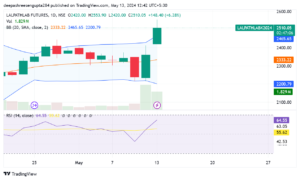LALPATH, a leading provider of diagnostic and healthcare services in India, has garnered significant attention from traders due to its potential breakout above the 2532 level. This detailed positional trade analysis aims to delve deeper into LALPATH’s current status, analyze recent market developments, and provide a comprehensive trade setup with associated risks and opportunities.
Company Overview:
LALPATH is a prominent player in the diagnostic and healthcare services sector, offering a wide range of diagnostic tests and services across India. With an integrated nationwide network, the company serves individual patients, hospitals, healthcare providers, and corporate customers. LALPATH’s offerings encompass core testing, patient diagnosis, disease prevention, monitoring, and treatment, making it a vital player in the healthcare ecosystem.
Con-Call Analysis:
Recent filings indicate that LALPATH conducted an earnings conference call, providing insights into its financial performance and operational updates. Analysis of the conference call can offer valuable insights into the company’s growth prospects, strategic initiatives, and future outlook. Traders should pay close attention to any significant announcements or guidance provided during the call, as they can impact market sentiment and influence trading decisions.
High Volume & Delivery:
Noteworthy market activity has been observed in LALPATH, with both trading volume and delivery surging significantly compared to the five-day average. This surge in volume and delivery, coupled with a 5.21% price movement, suggests heightened investor interest and potential momentum building in the stock. Traders should analyze volume and delivery patterns to gauge market sentiment and validate the breakout thesis.
Technical Analysis:
1. Breakout Signal: LALPATH is exhibiting signs of a potential breakout above the 2532 level, which serves as a key resistance barrier. A breakout above this level could signal a continuation of the uptrend and present an attractive trading opportunity for investors. Traders should closely monitor price action and volume dynamics to confirm the validity of the breakout.
2. Support and Resistance: Recent market developments indicate a reversal from the bottom, with the Relative Strength Index (RSI) shifting in the upper direction. This suggests a strengthening of bullish momentum and potential upward movement in the stock. Additionally, the breakout is expected after a period of long consolidation, further supporting the bullish thesis.
Trade Setup:

1. Entry Point: Traders are advised to enter the trade above the 2532 level, anticipating a breakout confirmation. This entry point ensures participation in the potential upward movement while minimizing the risk of entering prematurely.
2. Stop Loss (SL): To manage risk, a stop loss is set at 2500. This level is below the entry point and acts as a safeguard against potential downside risks. Implementing a stop loss helps protect capital and ensures disciplined risk management.
3. Target Levels: Multiple target levels are identified to capture potential gains as the trade progresses. The targets are set at 15, 30, 45, 60, 75, 90, and 100 points from the entry point, reflecting incremental price targets based on the anticipated upward movement in LALPATH. Traders can consider scaling out of their positions or adjusting their stop losses as the stock price approaches each target level.
4. Hold Period: The suggested hold period for the trade is a few weeks, allowing sufficient time for the anticipated breakout to unfold and for the stock price to reach the target levels. Traders should monitor the trade regularly and adjust their strategy based on evolving market conditions and price dynamics.
In conclusion, LALPATH presents a compelling positional trade opportunity for traders seeking to capitalize on potential breakout momentum. With favorable technical indicators, recent market developments, and a strong fundamental backdrop, LALPATH is well-positioned to experience further price appreciation in the coming weeks. However, traders should exercise caution, conduct thorough research, and implement proper risk management strategies to mitigate downside risks. As always, it is recommended to consult with a financial advisor before making any investment decisions.




